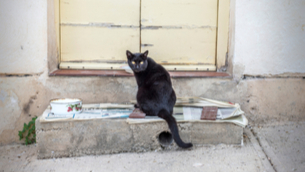Course Introduction
GUTS
| Rylan: | ¡Hola! Welcome back to GUTS, everyone. It has been a caffeine-fueled night here in the studio, but… we’ve done it! |
| Ceci: | Yes. We got down to business. We brought all of our ideas to the table, had some heated debates… |
| Rylan: | We laughed, we cried… |
| Ceci: | And in the end, we did it. Overall, a pretty good night! |
| Rylan: | Ok, Ceci, let’s tell our listeners what we’ve got in store for them. |
| Ceci: | Why don’t we show them instead? |
| Rylan: | Challenge accepted. Eso no es convencional, es... ¡ambicioso! Y... memorable. |
| Ceci: | Esas palabras son muy familiares. |
| Rylan: | Did you catch all those words? Convencional, ambicioso, memorable, familiares. All of these are cognates. I bet you know what they mean, and by the end of this introduction, you’ll be able to spell them, too. |
| Ceci: | That’s right. Today we’re going to learn more cognates, and show you just how easy it is to spell and pronounce Spanish. |
| Rylan: | Spoiler alert: it’s way easier than English. |
| Ceci: | Ok, where should we start? |
| Rylan: | Sounds and spelling. In Spanish, if you can say it, you can spell it, and if you can spell it, you can say it. |
| Ceci: | Just like that? |
| Rylan: | Just like that. |
| Ceci: | With no exception? |
| Rylan: | I dare you to find a single exception to this rule. |
| Ceci: | You’re on. |
| Rylan: | Ok, so each letter in Spanish – every vowel and every consonant – makes only one sound. Let’s take for example, the letter “a” in Spanish: It’s called “la letra a.” And it’s always pronounced “a.” |
| Ceci: | That’s true. Every time you hear the sound “a” in Spanish, you can be 100% sure that it’s spelled “a.” |
| Rylan: | By contrast, if you read the letter “a” in English, how do you pronounce it? Is it…. The /a/ in exact The /a/ in father The /a/ in about The /a/ in table |
| Ceci: | Sheesh. ¡Muy complicado! |
| Rylan: | English has 5 vowels – a, e, i, o, u – but 17 different vowel sounds! |
| Ceci: | Spanish also has 5 vowel letters, but only 5 vowel sounds. Simple as that. Each vowel has a name that also represents the sound it always makes. La letra a = A La letra e = E La letra i = I La letra o = O La letra u = U |
| Rylan: | Let’s say them again, Ceci! A, E, I, O, U |
| Ceci: | Per-fec-to. Now what about the consonants? |
| Rylan: | About half of them are just like English, and the rest only require a simple shift to learn. |
| Ceci: | Let’s start with those simple shifts. |
| Rylan: | In English, we have 2 different ways to pronounce C and G. We have a hard “c” sound - when c comes before a, o, and u – ca, co, cu. Similarly, we have a soft “c” sound - when it comes before e and i. With g, same story. We say “ga” “go” “gu”, and “ge” and “gi.” |
| Ceci: | Spanish kinda does the same thing. En español, we say “ca” “co” “cu”, and “ce” and “ci”. |
| Rylan: | Hey, ce-ci… ¡Ceci! |
| Ceci: | I guess my name is a perfect demonstration of the soft “c” sound. |
| Rylan: | And finally, en español, we say “ga” “go” “gu”, and “ge” and “gi.” The biggest difference here of course is that the soft “g” sounds like an “h”. That’s it! |
| Ceci: | In Spanish, the letter J, la jota, also makes an h sound. |
| Rylan: | Yes, always. And the letter H, la hache, is always silent! |
| Ceci: | Ñ, the n with the tilde accent mark on top, is rolled and sounds like an n + y. |
| Rylan: | Another letter that is rolled is the R. R like Rrrylan. |
| Ceci: | Sí, Rrrylan. A single R is rolled at the beginning of the word. In the middle of a word, like María, it is softer. |
| Rylan: | But the double RR, is always rrrrrrolled. |
| Ceci: | Ok señor, don’t get carrrrrried away. Let’s do the last two shifts. |
| Rylan: | In Spanish, the letter “v” always sounds just like a soft “b.” For example, vamos… |
| Ceci: | Vino. |
| Rylan: | Venezuela. |
| Ceci: | And the last letter of the alphabet, z, la zeta, always sounds just like an s. |
| Rylan: | And all the rest of the consonants sound just like they do in English: the letters ch, f, k, m, n, q, s, w, and y. |
| Ceci: | Ok, there’s one more thing we need to cover before we move onto Episode 1. |
| Rylan: | More cognates! |
| Ceci: | Cognate verbs and adjectives, to be precise. |
| Rylan: | Let’s start with the verbs. |
| Ceci: | Remember that all verbs in Spanish end in either -ar, -er, or -ir. |
| Rylan: | If it doesn’t finish with one of those three endings, it’s not a verb! |
| Ceci: | And like we mentioned before, due to the Latin influence on both Spanish and English, there are lots of words that are instantly recognizable. |
| Rylan: | AR verbs like activar, comunicar, investigar, motivar, |
| Ceci: | Organizar, participar, usar. And ER verbs like comprender, corresponder, defender. |
| Rylan: | Depender, mover, ofender, responder. And IR verbs like admitir, consistir, convertir. |
| Ceci: | Describir, existir, insistir, introducir. |
| Rylan: | Perfecto. So, basically, there’s no secret formula here. If you see an English word + AR, ER, or IR, chances are you will understand that word in Spanish. |
| Ceci: | Let’s finish up with a little discussion of adjectives. |
| Rylan: | Adjectives are easy. There are a bunch of them that are exactly the same in Spanish and English! |
| Ceci: | Words like casual, profesional, circular, popular, admirable, and flexible. |
| Rylan: | And then there are adjectives where you only need to make a small shift in spelling. Usually you just add an -o to the end of an English word to make it Spanish! For example: Correct. |
| Ceci: | Correcto. |
| Rylan: | Extraordinary. |
| Ceci: | Extraordinario. |
| Rylan: | Artistic. |
| Ceci: | Artístico. |
| Rylan: | Rapid. |
| Ceci: | Rápido. |
| Rylan: | Active...activo! |
| Ceci: | Of course, there are other cognate adjectives that don’t end in -o. Words like ágil… |
| Rylan: | Agile. |
| Ceci: | And juvenil. |
| Rylan: | Juvenile… For these words you simply drop the -e at the end of the English word. |
| Ceci: | And finally there are some English adjectives where we add an -e to get the Spanish. |
| Rylan: | Words like distant. |
| Ceci: | Distante. |
| Rylan: | And important. |
| Ceci: | Importante. |
| Rylan: | ¿Sabes qué más es importante? – You know what else is important? |
| Ceci: | Tell me. |
| Rylan: | Buckling your seat belts! |
| Ceci: | Um, why? |
| Rylan: | Well, because it’s the law. But alsoooo…. Because this is the end of our introduction and it’s time to get ready to roll. |
| Ceci: | That’s right, everybody. Estamos listos. We’re ready. |
| Rylan: | We are ready to get up to speed! |

























